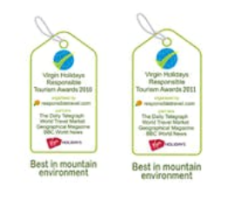The best reasons to visit Ladakh
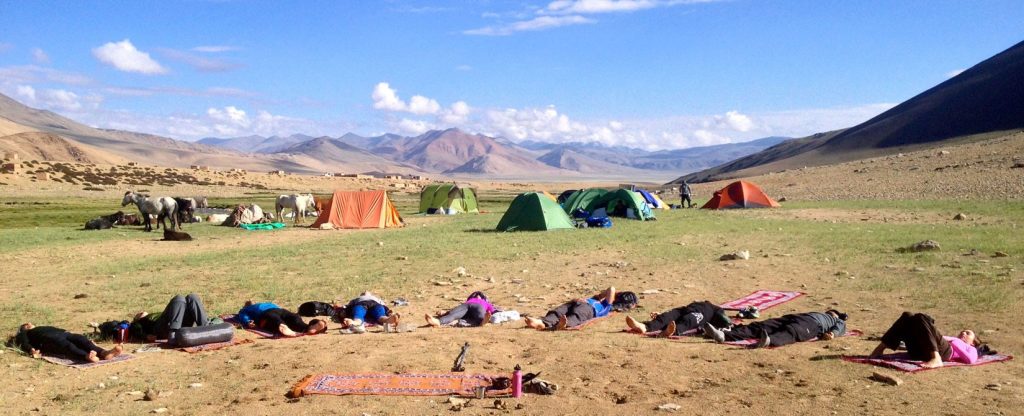
The best reasons to visit Ladakh To witness Ladakh’s stark beauty, one must travel to see it first-hand. Therefore, Ladakh has become a desirable destination, and travellers are thronging hordes to enjoy the natural beauty of the cold desert. Moreover, it has become a perfect destination for a rejuvenating vacation during India’s hot summer. If these reasons are not enough to get you on your feet, here are a few more reasons that a trip to Ladakh can be an experience of a lifetime. You need to know where Ladakh is first and foremost. This hot travel destination is mesmerizing visitors with its natural beauty. It is located north of the Great Himalayan Range, and the Karakoram range is in its north. Now that your mind is racing, here are some reasons why Ladakh should be considered your next destination to travel to. Trekking in Ladakh Ladakh is a paradise for adventure seekers, both novices and experienced ones. Adventure seekers from all corners of the planet to get their adrenaline fixed. Ladakh is also considered an ideal destination for both amateur and experienced mountaineers as well. Many trekking routes cater to beginners to the more serious adventurers. The adventurers experience the warm hospitality and the natural beauty of both the Himalayan and Karakoram ranges. There are several remote high-altitude plateaus if you want to beat the crowded trekking trails. You can go n a hike for several hours up to 30 or more days of extended trekking. Some popular trekking routes are The Sham Trek, Markha Valley, and Spitok to Stok and the longer and less crowded ones are in the Changtang and Zanskar regions of Ladakh. Rafting-in-Ladakh Ladakh is fast becoming an action-packed destination. One can go for half a day rafting on the Indus River or participate in a multi-day trip on the Zanskar River. It perfectly combines whitewater, scenic floats, peaceful villages with friendly residents, and numerous monasteries. Whitewater rafting is one activity not to be missed by the adrenaline junkie. High Altitude Lakes and Wetlands There are numerous Turquoise lakes in Ladakh. For Indian tourists, Pangong Lake is the most popular as it was featured in a Bollywood Movie. More than 70% of this lake is in Tibet (Aksai Chin area – the Chinese in the 60s captured it). This lake is 120km long. The Tsokar (Salt Lake) and Tsomoriri Lakes should interest you, wildlife and bird lovers. These lakes and the surrounding wetlands are breeding grounds for several endangered species of birds. The migratory birds breed during the short summer season before flying to less cold places for the winter. Some of the rare birds that migrate for the summer are Pochards, Terns, Bar Headed Geese, and Black-Necked Crane. Thikse Monastery Ladakh is not just a place for thrill-seekers and adrenaline junkies but also a paradise for those seeking spiritual peace. There are numerous yoga classes and meditation courses during the summer season. Ladakh is marked by many monasteries, prayer walls, and Stupas. One of the popular sightseeing tours is of three monasteries, namely Spituk, Hemis, and Thiksey. Despite being a Buddhist majority, Ladakh people live in peace with their Hindu and Muslim neighbours. Festivals in Ladakh Ladakh is also known as the land of Festivals. They hold numerous Festivals in various monasteries. These Festivities are famous for their colourful costumes and mask dances, and everyone is in a jolly mood. Winter is a fantastic time to visit Ladakh; if you want to witness some festivals when it is not crowded, some hotels will still be open, rooms should be easy to book, and the flights should be much less expensive. The hotels that open during the winter have made heating arrangements. Some of the Monasteries that hold the winter festivals are Thiksey, Chemrey, Spituk, and Matho. Check out our Trekking packages for Nepal, Bhutan, India, and Tibet.
Ten benefits of using trekking poles
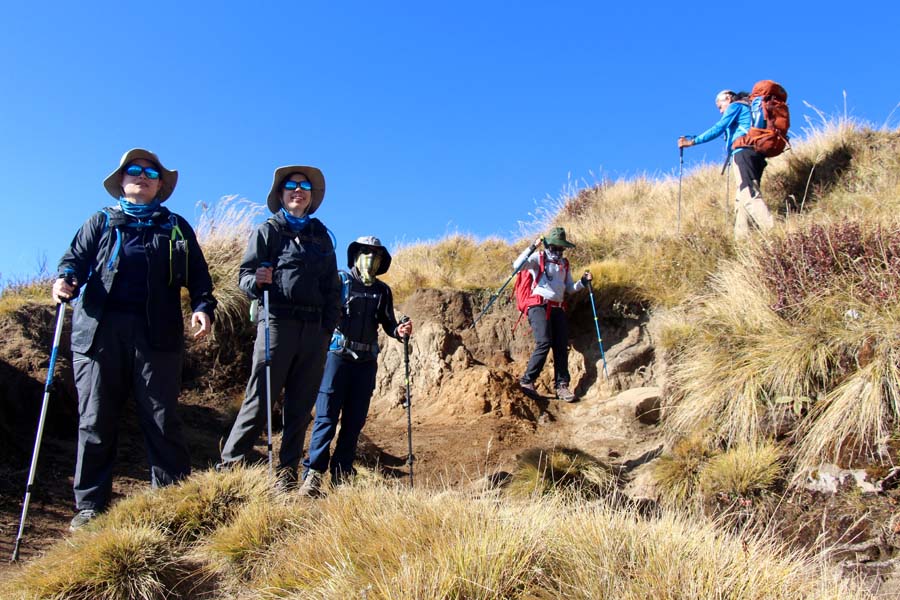
Ten benefits of using trekking poles We used to laugh at trekkers using trekking poles in the late 80s and 90s. However, I started using trekking poles in 2004 and have found them extremely helpful. Now I cannot imagine trekking without my hiking poles. I have learned that they are convenient and helpful while on extended treks. 1. Helps in maintaining a constant pace Getting into a rhythm can help you get past many kilometres with a trekking pole – be it on relatively easy or demanding terrain. After a few short minutes of starting the trek, one gets into a steady hiking pattern, helping maintain a constant pace. Trekking poles can help add an element to the groove while keeping you focused. 2. It provides a boost on ascends. The legs must work very hard while going uphill for an extended period. Utilizing the hiking poles can help boost yourself uphill with your arms, and it takes some stress off your leg muscles while giving your arms some exercise. In addition, it can help you save some energy and cover more ground. 3. Save your knees on downhills Being 193cm in height, the downhills were all right during my younger days. However, I started to have aching knees and sore legs after extended descent when I reached my 40s and started using the poles. It helped tremendously to absorb the continuous pounding my knees had to take on each step. I have learned how to spread the strain to my arms using the poles and ease my joints’ weight. The bars also help with stability on significant steps and steep sections of the trail. 4. Great for balancing on slippery rocks or uneven terrain Many times, I trekked through muddy, wet, icy trails where I could have been seriously injured without my trusty hiking poles. They have saved me countless times and have prolonged my trekking career. 5. Helpful during river crossings I call the trekking poles my extended arms or my four-wheel drive. They have been instrumental in crossing streams or rivers to help keep balance and make giant leaps. They are also great for keeping your while wading in swift rivers, proding for shallow parts to get to the other side safely and dry. 6. Keeping spider webs, prickly bushes and branches, away Once again, the many uses of trekking poles are to push branches and thorny bushes out of the way while on the trail, especially after the monsoon season, when everything is lush and overgrown. You can even use it to push away spider webs to avoid them getting on you or the nettles from stinging. 7. Checking out a loose rock before stepping onto it It is not uncommon to come across steps or stones that are unstable and shaky. You can use a pole with some weight to test the step or rock to see if it can take your whole load. This is another situation when the trusty hiking poles come in handy and save you from a potential injury. 8. Keeping animals at bay. When trekking on the popular trails in the Himalayan regions, you will encounter animals such as snakes, rodents, goats, sheep, ponies, mules, and yaks. If you feel threatened or the more giant pack animals are coming too close for comfort, you can use your poles to push them away. Likewise, you can wave your sticks if you come across an aggressive dog in a village or on the trail. 9. For emergency litter or splint construction You could come across several emergencies when having a sturdy, straight, and light brace can be helpful. The poles can be improvised with lots of padding for splints on broken bones or as support on sprained joints. It can also be used as crutches in case of an injured knee or rolled ankles, and the need to keep weight off it arises until you get proper help. 10. Makeshift tent You can even use it to set up a makeshift tent using a tarpoline, even when camping is not planned. You can also plant the poles firmly on the ground, tie a string between the two poles, and dry your wet clothes or socks. These are some practical benefits of using trekking poles when hiking. There are cheap knock-off versions available in Kathmandu. The cheap poles are the draw of luck; some might last you the whole trekking period or be broken within a couple of days (personal experience). I would advise you to invest in sturdy branded trekking poles such as the ones made by Black Diamond or Leki. Check out our Trekking packages for Nepal, Bhutan, India, and Tibet.
Spectacular Monasteries in Ladakh where you can stay to unwind
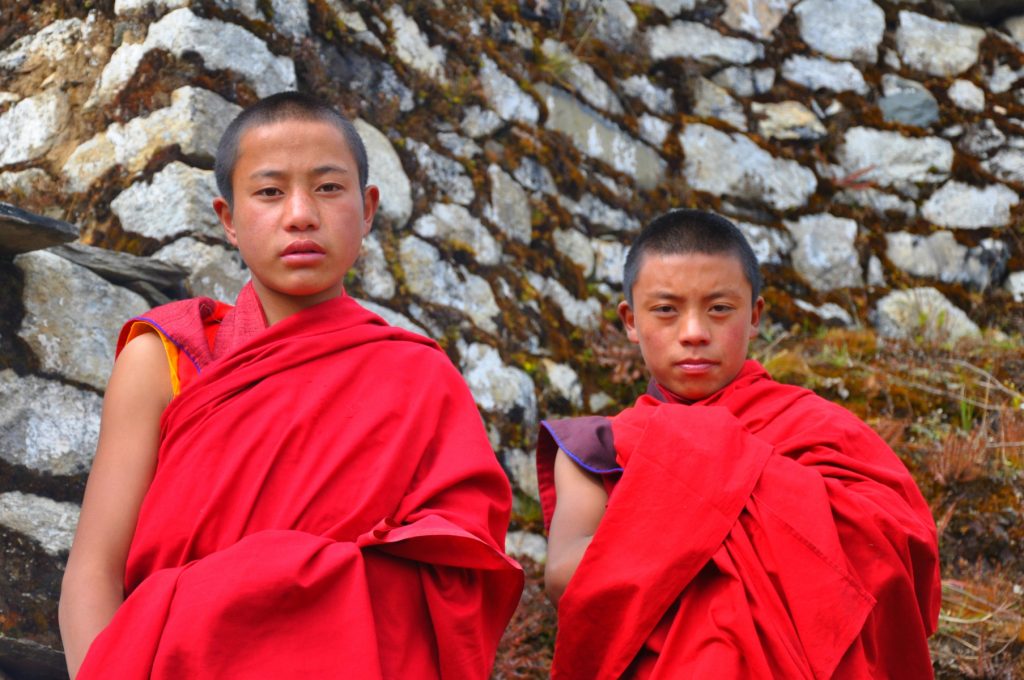
Spectacular Monasteries in Ladakh where you can stay to unwind Ladakh is fast gaining a reputation amongst travellers for its incredibly ornate monasteries. These monasteries are part of Ladakh’s rich culture through their architecture, paintings, and ancient texts. Some of the monasteries have begun to allow visitors to stay. Here we have some monasteries that enable visitors to remain on their premises. Thiksey Monastery Thiksey is one of the biggest and most famous monasteries in Ladakh. It is renowned for its magnificence in architecture, religious importance, along spectacular views. This monastery welcomes guests with gracious hospitality. The monastery provides rooms with essential amenities for an intimate experience of Ladakhi hospitality for a limited period. You can meditate in the peacefully serene ambience and watch the monks and nuns g about their daily routine. You can also go into the monastery’s well-stocked library and learn more about Buddhist spirituality science. Lamayuru-Monastery The Lamayuru Gompa is undoubtedly the most captivating of monasteries outside of Leh. The area close to this monastery is also called “moonscape” due to the terrain’s interesting appearance. Like most monasteries, it is set away from the town in its serene surroundings while allowing the chanting’s power can get you into a trance of peace and contemplation. This monastery is located on the Leh to Srinagar highway. You have several options to either go for a homestay, stay at the village guest house, or stay at the monastery. An excellent restaurant within the monastery specializes in delicious Tibetan food. Hemis-Monastery Hemis Monastery is the most significant and wealthiest monastery in all of India. It is situated a few kilometres from Leh town, in a barren environment. The monastery is well known for its annual Hemis festival with its vibrant rituals, colourful mask dances, and perfect ambience. The Hemis monastery accommodates tourists who want to stay for an extended period. The spectacular scenery and surroundings give one peace of mind. This monastery is visited by thousands of tourists each year, and the numbers keep increasing annually. The attendance of the morning prayers can get you in a zone. The Hemis monastery is one of the must-visit institutions in Ladakh. Phuktal Monastery The Phuktal monastery is built in complete isolation around a cave on the slopes of a rugged hill. It is one of the most breathtaking monasteries in the Zanskar region of Ladakh. It is a two-day drive from Leh, which makes it quite challenging to get there. The main monastery is inside a cave. The architecture reflects the beauty of the ancient Buddhist art form. Visitors are reluctant to leave because of the absolute serenity of the surrounding. Visitors can opt to stay at the accommodation available for short stays. The experience of staying at this monastery can be mind-boggling with the peaceful atmosphere and the breathtaking scenery. You can participate in the prayer ceremonies and witness the rituals. The resident monks are ever so willing to share their knowledge with you. Take advantage of the monks’ remote location and genuine hospitality to make the most of your cultural and spiritual experience. Rangdum Monastery The Rangdum monastery is another of Ladakh’s delightful monasteries, snuggled in an isolated part of Zanskar Valley. The Gompa is constructed on a hill overlooking a small village below. Trekkers on the Zanskar trek often stay near its vicinity. Some trekkers opt to camp within the premises of the monastery, which is peaceful. It is a relatively small monastery with about 40 resident monks and a few cattle. Life at the monastery continues as it has done for the past few centuries at its own pace. The monks are friendly and willing to converse with visitors during their free time. They share their knowledge of their religion willingly during your stay with them. You can volunteer to help with the chores, explore the surroundings, mingle with the villagers, and visit the village’s amiable residents.
Qualities of an excellent trekking guide or trek leader
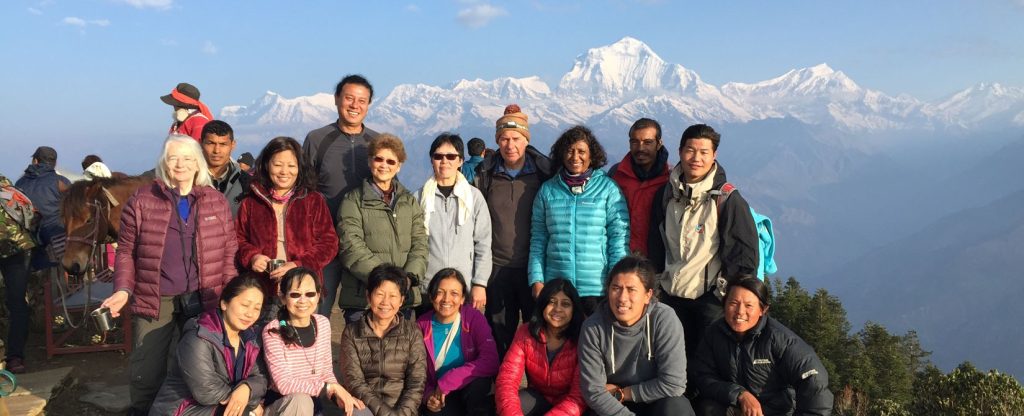
Qualities of an excellent trekking guide or trek leader. To be an excellent trek leader, one not only needs to have charisma, knowledge, communication skills, storytelling abilities, and organizational skills; sometimes, you also need to be a father figure, psychologist, counsellor, even mediator, and a mentor to not only to the clients but the support crew as well on infrequent occasions, even a lead manager of crisis and a Wilderness First Responder. Several “top-notch” City Tour guides were interviewed for their thoughts on Trek leaders’ jobs in a recent recruitment effort. Most were doubtful about their fitness and ability to handle the mountains” hardships and discomforts. They preferred the ‘more cushy” job of guiding in the urban areas with comfortable hotels and good food – basically the “Good easy” life as a guide. This interview has confirmed our previous belief that great trek leaders are true gems worth their weight in gold. 1. Charismatic personality: No matter the size of the group, there’s often just one main group leader for each trek and several assistant guides. Unlike in city tours, a trek leader is in charge of making the trekkers happy and looking after his team member’s welfare in the support crew. The clients will not be expecting information but also entertainment. A trekking group leader must have an abundance of charisma, charm, and a great sense of humour is a bonus. 2. Knowledge is paramount: Charismatic leaders are great, but they cannot have charm alone. A great trek leader needs to know what they are talking about: from facts and figures to the weather forecast for the coming days. Give summaries on the subjects you are talking about and ask the clients if anyone wants to learn more details. Don’t bore them with long talks of history/culture/nature, etcetera. A great trek leader could be very knowledgeable, but they are not a walking encyclopedia. If asked about something you do not know about – DO NOT MAKE THINGS UP and LIE! Someone in the group will pick up the lie. Once they discover that you have lied: you will lose all credibility, and it does not matter that you did your job exceptionally well for 20 days on a 21-day trek; they will think you must have lied to them throughout the trip. Tell them that you do not have the answer to that particular topic but will update them once you learn more about it. You will receive many “curveballs,” especially early in your career; contemplate how you responded to them and try to handle those situations better the next time. Nowadays, it is easy on more commercial trials to get wifi connections. You can always search for answers online. 3. Excellent communication skills: You might have incredible knowledge and outstanding charisma. Still, if you do not have “people skills” to interact with the group, they will probably feel like listening to a pre-recorded tour. Trekking vacation is very different from regular bus tours. Your clients will spend extended periods out of their comfort zone, making them comfortable, chatting, and joking with them. Ask them how things are different from where they come from to where they are. Ask them to speak about themselves, what they do, what they like, etcetera. Most people want to share their passions and favourite things with new friends. Make sure you are paying equal attention to all group members and engaging everyone in participating. 4. Excellent storytelling ability: Trekkers love to hear about cultures, religious practices, and the history of the region they are trekking in; they like listening to stories. Therefore, a great trek leader needs to be an excellent storyteller. Storytelling is not straightforward; it is down to timing, how long the story is, and much more. Plan precisely when and where you will tell a particular story, decide how long it should be, and practice it until you know it, like the back of your hand. Reminder: Storytelling is not making things up – it is the same as lying! 5. Excellent organization skills: Timing is of the essence when you are leading a trek. You need to be at specific places at specific times; you need to get to where the lunch place has been chosen and to your campsite at the end of the day. The group can only spend a certain amount of time in places for photos, admiration, etcetera. So you have to shepherd the group by giving them enough time to observe & absorb the surroundings at the same time, gently reminding them where they need to reach at the end of the day and hopefully before it gets dark. Look at the given timings for each day for the hike; if some people take longer, add more time to reach the destination. If most of the group is slower than regular trekkers, start earlier in the morning. If the need arises, make those rest days into hiking days to compensate for their slowness (provided their acclimatization to altitude is not compromised). 6. Good sense of humour: It is an asset if you can lighten things up with occasional jokes here and there. For example, making fun of yourself to make the group smile is a safe way to avoid upsetting group members by making jokes about them. In addition, you can add humour to the stories you tell by pointing out a funny situation or lighthearted facts. 7. You must be sensitive: Not all group members have the same fitness level, and someone might have low self-esteem from being the last person to arrive at the campsite every evening or suffering from diarrhoea or other ailments. An excellent trek leader needs to be sensitive, supportive and encouraging during situations like this. Understanding human psychology and being compassionate can make problem-solving a lot easier. 8. You need to think on your feet: As a trekking guide, you need to be spontaneous. Your day can be unpredictable; the weather can quickly change, bridges might be
What to expect on the Mardi Himal trek

What to expect on the Mardi Himal Trek In the 80s, only a handful of trekking companies organized camping treks to this region’s expedition-style camping treks. However, as recently as 2011, some lodges have opened up at strategic points for trekkers to do lodge/teahouse trekking to Mardi Himal. The area lies east of the Annapurna base camp trekking trail. It is the right combination of walking through some villages on the famous Annapurna trail, secluded forest, open ridges, and rugged mountain terrain with Mount Machapuchhare’s (Fishtail) shadow. As a result, this trek is fast gaining popularity with trekkers both from overseas and locals. Mardi Himal Trek is an excellent alternative to the ultra-popular Poon Hill trek with fewer trekkers, gaining popularity. However, the lodges are very basic, with a similar food choice on the menu, as on the main Annapurna trail. The trails can be pretty secluded with some signboards with arrows pointing to the next destination. Here is a sample itinerary for this trek. Day 1: Pokhara to Kaande, Pothana 1900 meters, or Pitam Deurali 2300 meters. You can either get into a local vehicle or rent a private transport to drop you off at Kaande – an hour’s drive from Pokhara. From Kaande, it is a steep 2-hour ascend to the Australian camp passing through small villages at the beginning. On clear days terrific panoramic views can be expected at the Australian camp at 2100 meters. You can either stop for some drinks or have lunch here when you arrive here. If you come here early, you can hike down towards Pothana village as another option for lunch. The hike is through a forest until you reach Pothana 1900 meters. You can either stop here for the night or climb a little under an hour to reach Pitam Deurali 2300 meters. The lodges here are very basic except for one new one that was ready in spring 2016. It makes the next day’s trek to Forest camp a shorter hike. It can take as long as 7 hours from Pothana. Day 2 Pothana / Pitam Deurali to Forest Camp (Kokar) 2600 meters. It would help if you took a packed lunch and enough water to last you the whole day as there is no lodges or tea house to stop for refreshments on the forest trail. It takes around 6-7 hours from Pothana and 5-6 hours from Pitam Deurali. From Pitam Deurali, you leave the main Annapurna trail and start climbing in the Rhododendron forest. This path was the shepherds’ trail bringing their animals to higher pastures during the summer monsoon. Several trails lead to some neighbouring villages. You need to try and stick to the widest and what appears to be the most trodden trail (this can be tricky if you are there early post-monsoon), which is again a good idea to trek with other trekkers or book your trip with a trekking company for safety. You will be walking on the ridge of the forest, with some ascends, mostly with occasional descends. You can stop at one of the several openings to have your packed lunch. There are only three lodges at the Forest camp. It is in a beautiful setting, as the name implies, in the middle of a forest. Day 3 Forest Camp / Kokar to Low Camp 2950 meters or further on to Badal Danda 3250 meters. The trail continues to climb gradually in the Rhododendron forest. You will reach Low camp in about 3 hours. It is an opening in the woods with three lodges. Some trekkers stay here for the night or continue to Badal Danda or high camp. You can have lunch here and go on for another hour of an uphill climb to Badal Danda, be informed that there is only a single lodge with six rooms. If you manage to get a place, Badal danda is above the tree line, and on clear days, spectacular views of Machapuchare, Mardi Himal, and Annapurna South can be seen. There is a point above the lodge on the left for spectacular views in the morning for sunset or sunrise the following day. Badal Danda to High Camp 3550 meters. The trail is on a ridge of the hill with small shrubs above the tree line, with Annapurna South, Machapuchare, and Mardi Himal dominating the North’s skyline, a broad valley to the east. Finally, one can see the trekking trail to Annapurna base camp about a thousand meters below the West. High camp is a small open pasture with three lodges. Mardi Base Camp 4500 meters. The trail is narrow and exposed at some parts with sheer drops. You need to be very careful at those points; forget about going higher if you are there in winter and snow. You will reach an area with a sign that says MBC in two hours, it should be good enough to arrive here, but the “proper “Basecamp is a further 2 hours away. Remember, you must walk back the same way to High camp. The views are fantastic even at just an hour’s walk from the high camp. Forest Camp 2600m Retrace your steps back to Forest Camp. You will find it a fascinating hike downhill with more oxygen to appreciate the scenery better. The total walk is about 5-6 hours. Forest Camp to Lwang Ghalel 1500 meters. The trail descends steeply through rhododendron and Oak forest to the permanent settlements closer to the valley basin. From this point, the trail contours and is undulating. Lwang is a Gurung village with a rich culture and traditions. There are homestays in this village that provide you with an excellent opportunity to experience the Gurung Clan village lifestyle. The Mother’s group will make you a traditional Nepali staple of Dal Bhat (rice, lentils, vegetable curry, spicy sauce, and maybe even chicken curry) with fresh organic ingredients. If you are in a small group, you can also ask for a cultural evening for a small donation.
What to expect when trekking on the Manaslu Circuit

What to expect when trekking on the Manaslu Circuit Mount Manaslu is the eighth tallest mountain in the world at 8156 meters. The local name for Manaslu is Kutang – Spirit Mountain. The government of Nepal only opened this area to trekkers in 1991. For more details on the Manaslu area, you can visit Wikipedia. In recent years, Mount Manaslu Circuit trekking has been gaining popularity rapidly. Unfortunately, part of the Manaslu region’s trails was damaged by the massive earthquakes of April and May 2015. To date, only bona fide trekking agencies of Nepal are permitted to run trekking tours around Manaslu. Backpackers are forbidden to roam alone in this region. You can start this trek by taking a local bus/jeep or a private jeep to Arughat or driving for an additional hour or so to Soti Khola to begin the trek. The trail starts with narrow valleys with tropical vegetation while hiking along the Budi Gandaki River. Parts of the path are small, with loose rocks used as steps, and several places can be potentially dangerous, especially when you encounter passing caravans of mules. As you begin to gain altitude, you will notice the change in the landscape becomes austere, and at the same time, the people who were Hindus in the lower valleys now see Buddhists in the higher altitudes. You will pass through Machi Khola, Jagat, Ghap, Lho Gaun, and Samagaon with impressive views of Manaslu, Ganesh Himal, and other smaller peaks of 6000 meters. It is recommended that you spend one extra night at Samagaon for acclimatization. The average hiking days are between 5-7 hours each day. On average, it takes about six days to reach Samagaon from the day you leave Kathmandu. On an extra day, you can hike up towards Manaslu Base Camp. After climbing through the pine forest, you will see the impressive turquoise Birendra Tal (Lake). The hike to Manaslu Base Camp takes between 5-6 hours, and another 3-4 hours to get back to Samagaon – it is not recommended unless you have brought your tent and some camping food for one night. However, it is good enough for acclimatization if you walk about two hours from Samagaon, enjoy your packed lunch amidst stunning scenery and head back to Samagaon. The other option is to hike to Pun Gyen Gompa – ask the locals for directions; the round trip takes about 6 hours. You will pass through yak pastures and a grassy plateau with dramatic mountain scenery. There is a small monastery with a little prayer room with dormitories for the monks. It is only worth the effort on clear days. You can also camp here if you have brought your tent and some camping food, as no accommodation is available here. Samagaon and onwards. The trail from Samagaon to Samdo is flattish and takes about 4 – 5 hours to get there. From Samdo, the path to the right goes towards Tibet. You might see caravans of Yaks returning with loads from Tibet. Depending on the time of year, ask the locals if the lodge at Dharamshala is open. It is closed from the 3rd week of December until March. The next morning is another short day in Dharamshala. The trail combines gentle ascends with short bursts of steep climbs. Again, look out for Blue Sheep around Dharamshala. The lodge here is very basic, with drafty walls in the room – so a suitable sleeping bag is a must — 4-5 hours of trekking at a comfortably slow pace. The day you go over Larke La 5160 meters, you will walk alongside a glacier with a glacial Lake Cho Chanda. Upon reaching the top of the pass, you will witness a superb panoramic view of Himlung Himal 7126 meters, Cheo Himal 6820 meters, Gaygi Kung 6981 meters, and Annapurna II 7937 meters. The Larke La pass is the natural border between the Manaslu and Annapurna regions. The descent is steep and slippery to Bimthang. This is a lovely spot with beautiful views of the Manaslu range. The last day of trekking in the Manaslu route takes you through a beautiful forest, passing through terraced fields amidst a small village until you reach Dharapani, which is on the Annapurna Circuit trail. You can continue trekking onwards to do the Annapurna circuit or walk to Besisahar or get a jeep to Besishar and get into a local van or bus to Kathmandu or have a vehicle booked from Kathmandu pick you up at Dharapani and bring you back to Nepal’s capital. Check out our Trekking packages for Nepal, Bhutan, India, and Tibet.
List of Luxury Hotels in Nepal
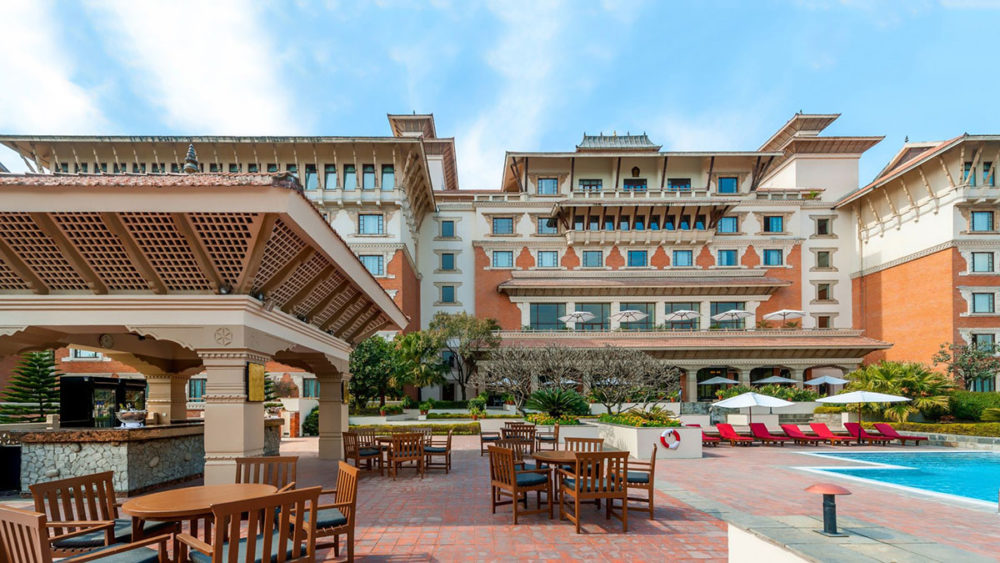
List of Luxury Hotels in Nepal Luxury hotels in Nepal are mainly available in larger cities like Kathmandu, Pokhara, Chitwan, Lumbini, and Nepalgunj. While on the other hand, smaller villages and destinations offer cosy and comfortable lodges. Whether you go on a long and strenuous path to Everest or the more gentle tracks around this Himalayan nation, it is necessary to have a comfortable place to rest. Nepal’s hotels are spread around some of the most spectacular locations, and most benefit from captivating mountain views. Many have adapted local character using materials locally available such as terracotta, red brick, and thatched roofs. Some high-grade accommodation includes luxury jungle lodges, traditional converted mansions, and beautiful rural retreats. All of them offer organic food and spa treatments. We also provide luxurious lodges in the Annapurna and Everest regions. You will get the best experience on an organised trek (unlike turning up on your own). The excellent selection of luxury lodges in the Everest region’s lower reaches allows you a two-week-long trek to Ama Dablam Basecamp and surrounding villages. These lodges prioritise trekking companies, but independent trekkers can also stay in these hotels. There are comfortable hotels in Kathmandu and restaurants serving delicious meals, while the lakeside in Pokhara is also home to some luxurious accommodation. All accommodation has been hand-selected carefully by Responsible Adventures to ensure that all accommodations are well-located and include a high degree of hospitality. For a comfortable and memorable stay in Nepal, Responsible Adventures can make hotel reservations in any category of hotels ranging between 3-star and five-stars in Kathmandu, Pokhara, Chitwan, Nagarkot, Dhulikhel, Lumbini, Bandipur at very competitive prices. Browse our portfolio of hand-picked hotels, lodges, and resorts in Nepal, listed below in the order of the popular locations: RADISSON HOTEL – KATHMANDU It is situated in the city’s heart; this hotel is finely located for local sightseeing within Kathmandu and the valley. The hotel can be reached within a ten-minute distance from Thamel and Durbar Marg’s favourite city. It has 163 well-appointed modern rooms. Each room includes superior and club rooms as well as deluxe suites. The hotel offers facilities such as the Splash Bar and Grill, an excellent rooftop restaurant, and a swimming pool with views over Swayambunath and the nearby mountains. Guests can enjoy stunning sunsets and a range of cocktails, and nightly roosts. DWARIKAS HOTEL – KATHMANDU The Dwarika’s Hote was the conception of a man’s dream to preserve Kathmandu’s architectural heritage. It is a unique hotel to stay in with lots of character. It can be considered a living museum. The 87 comfortable rooms and suites have an individual style and have won numerous awards and accolades. Custom-made furniture decorates the 74 spacious rooms and is situated around the serene courtyard at the hotel’s heart. They are in-house restaurants that offer some of the best food in town. This family-run 5-star hotel is a saviour of Newari architecture and craft that dates back to the ancient Malla dynasty from 1201 to 1769. Kathmandu valley is tearing down old buildings in its rush to modernise. Buddhist symbols on hand-printed curtains and bedspreads are used with traditional fabrics and accessories. The hotel is located within walking distance of the sacred Pashupatinath Temple and about a 20-minute drive from the city centre. HOTEL YAK & YETI – KATHMANDU This 5-star Hotel Yak & Yeti is located in Durbar Marg, a 10-minute walk from Thamel and a 15-minute drive from the centre of town and Tribhuvan International Airport. All the rooms are equipped with central air conditioning, attached bathrooms, satellite television, tea & coffee making facilities, and a minibar. It is decorated in beautiful colour palettes. Some of the rooms have a personal safe and bathrobes. The historical fountains and lush gardens surround the hotel. It also has a casino, tour desk, health club, and tennis courts. They provide accessible parking. The hotel also offers laundry and dry cleaning services. The casual Sunrise cafe overlooks the garden and pools. The Chimney Restaurant and pub’s pleasant environment provides a lovely ambience for a good meal and drinks. They also offer Halal meals. The Hyatt Regency – Kathmandu The Hyatt Regency is located in Kathmandu at a 10km distance from the city centre, on the road to Boudhanath Stupa, the holiest Tibetan Buddhist shrines outside Tibet. This hotel is considered the best in Kathmandu regarding accommodation and facilities. It has 284 rooms and six suites. The hotel is built on 37 acres of gardens. Soaltee Crown Holiday Inn Plaza– Kathmandu The Soaltee Holiday Inn Crown Plaza is situated in the suburb of Tahachal. The hotel has a total of 283 pleasantly decorated rooms. The rooms are equipped with elegant air-conditioning, cable T.V., and a minibar. The Soaltee boasts five world-class restaurants that offer continental, French, Oriental, Italian, & Indian cuisine. In addition, the hotel offers a wide selection of facilities, including a swimming pool, health club, an eight-lane bowling alley, and is home to Nepal’s oldest and largest casino. The Pavilions Himalayas The Pavilions Himalayas is nestled in the natural paradise of a lushly forested valley set against the impressive Himalayan mountain range’s backdrop. The Pavilions Himalayas is the first genuinely eco-sensitive luxury boutique resort in Nepal. They proudly grow their vegetables and dairy products on their organic farm. The perfect settings and natural beauty reflect Nepal’s deep historical heritage, while their tranquil environment is excellent for undistracted meditation. Whether adventurous or contemplative, you will appreciate the resort’s deep commitment to sustaining the natural environment. They also have a particular interest in the welfare of the people of Nepal. The Tiger mountain lodge Pokhara. The Tiger Mountain Lodge Pokhara is 1,000 feet above the Pokhara Valley with a spectacular Himalayan backdrop. It provides a perfect escape to enjoy the essence of tranquillity. It is ideal for guests pre- and post-trek. It is very suitable for those who wish to take day hikes to explore local communities or bird-watching or gentle exercise, or relax in a typical Nepalese rural setting. They are
Leave No Trace Raising Environmental Awareness In The Nepal Himalaya

Leave No Trace Raising Environmental Awareness In The Nepal Himalayas Leave No Trace is a set of outdoor ethics that promotes outdoor conservation. There are seven principles of its practice. Planning and preparation. Travel and Camp on durable surfaces. Proper waste disposal. Leave what you find, Avoid campfires if possible; otherwise, minimize their impacts. Respect wildlife. Be considerate to other visitors. These principles have been adapted to various ecosystems, environments, and activities. Leave No Trace Center For Outdoor Ethics, a nonprofit organization known as Leave No Trace (LNT), has existed since 1994 to educate people about their impact on nature through their recreational activities and Leave No Trace principles to prevent or minimize such effects. We at Responsible Adventures have continually educated our trek leaders, support crew, and porters on how to trek in an environmentally friendly manner. Some porters have even started collecting rubbish they see in their resting places. I led a group from Poland on a remote Upper Dolpo traverse trek from Late September until the middle of October 2017. We saw that even this remote region, which has a relatively small number of trekkers compared to other Nepal trekking areas, was beginning to get some form of rubbish at the trails and campsites. “It is one of the cleanest areas I have trekked in, and it must be kept in its pristine state. “There were constructions of a growing number of lodges in anticipation of more foreign and local trekkers. With rapid development without proper education on environmental issues, the locals do more damage than benefit the locals and their sensitive surroundings. My first opportunity was to meet the newly elected Mr Tashi Tundup Gurung – Head of Shey Phoksundo Village Municipality, at his home in Saldang village. I formally introduced myself to him and sat down to have a serious talk with him after exchanging pleasantries. I asked him what his thoughts on tourism were, to which he replied that it benefits the people of inner Dolpo very little. The trekking companies hire pack animals and buy most rations for this camping trek in the lower regions, despite fresh vegetables and rations being available in Dolpo’s interior villages. I told him how beautiful his District was and how important it was to educate the new entrepreneurs and the staff of camping groups about keeping the surroundings clean. Mr Tashi mumbled, why bother when they receive no benefit? I told him this was why they should insist all camping groups bring out the rubbish they produce; the villagers should tell the trekking group’s staff that they are welcome to visit their beautiful District and understand their culture and religion but leave their environment pristine. To encourage him further, I said that the Dolpa district could lead the country on Leave No Trace principles by cooperating with neighbouring Village Municipality chiefs to implement these policies. Despite being new on the trekking scene and being a very remote district, they can be ecologically sound. This got Mr Tashi excited, and it was evident on his face. He thanked us for visiting and educating him on environmental issues and sounding my concerns for their District. Awareness needs to start at the grassroots level to implement LNT policies; I spoke to our mule drivers, Kaji and Bhim. They were reluctant in the beginning. However, they were convinced that trekkers could go to many other areas or countries should their District become dirty. This is part of our ongoing Responsible Tourism Practices. Check out our Trekking packages for Nepal, Bhutan, India, and Tibet.
How to trek safely in Nepalese mountains
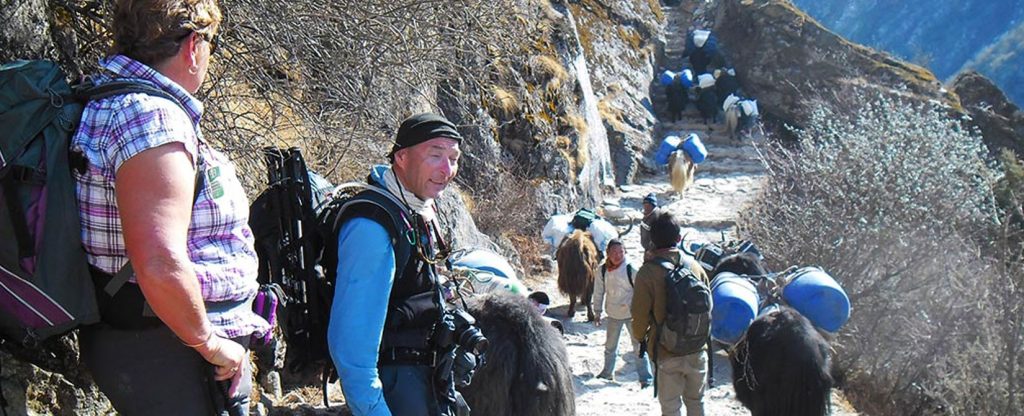
Learn how to trek safely in the Nepalese mountains Updated 13/12/2023. Here is some advice on remaining safe while trekking/hiking on the trails. Always walk on the wall side of the trail. You may encounter caravans of pack animals or porters carrying large loads. You wouldn’t want to be pushed off accidentally. Don’t listen to music using earphones, as this will prevent you from hearing oncoming caravans of pack animals. When you come across wet stones or rocks with algae on a damp trail, assume it is slippery and possibly dangerous. You will come across fascinating sceneries, villages, people and wildlife. Stop to admire, observe, or photograph them. Plenty of stones and rocks are on the path; you don’t want to trip on them and injure yourself. Use Sunblock of factor 30 or more. Have a sun hat, warm hat, waterproof and 2 litres or more water to drink. Camelback is the best equipment to carry water as it provides easy access to water while trekking. Walk at your own pace. Listen to your breathing. If you are huffing and puffing while trekking, you are going too fast for your lungs. At altitude, you are seriously advised to take it slowly and steadily. If possible, do not ascent more than 300 meters in a day. Have an acclimatization day every 1000 meters. Ascending too fast can lead to Acute Mountain Sickness. Sudden movements can cause you to be breathless or dizzy at a high altitude. Drink plenty of nonalcoholic fluids such as water, juice, hot chocolate, soup, etc. Try to minimize the intake of coffee and tea, as both are diuretics, which cause you to pee more. Do not take medicine with suppressants such as codeine or similar ingredients. Now and again, trekkers go missing in the mountains. You would not want to be another statistic, would you? DO NOT travel solo in the wilderness. Always inform your embassy or family and friends when you need to go alone and give them your travel route. Inform them of your whereabouts via phone, text, email, or social media when you can access the internet or whenever possible. When you walk through landslide areas, look above for passing animals, which can cause rock falls. These precautions can be utilized for trekking safely in Tibet, Bhutan, Ladakh, Sikkim, and Darjeeling in India. Do not pet or feed animals. No matter how cute dogs, cows, buffaloes, or other animals look, DO NOT pet them. One can never tell how the animal feels; you might get bitten. If you are trekking during the summer in Ladakh’s rain shadow areas, Upper Mustang, Upper Dolpo, Humla, or Tibet, be careful when you come across sheep or yak herders’ campsites. They have big Tibetan Mastiffs that can be aggressive as they protect their herds and flocks in the high summer pastures. Be careful in early autumn when you approach high-altitude villages of these mastiffs, as they can still be protective when they have just arrived from the summer grazing pastures; they can give you some nasty bites.
Important facts about Bhutan
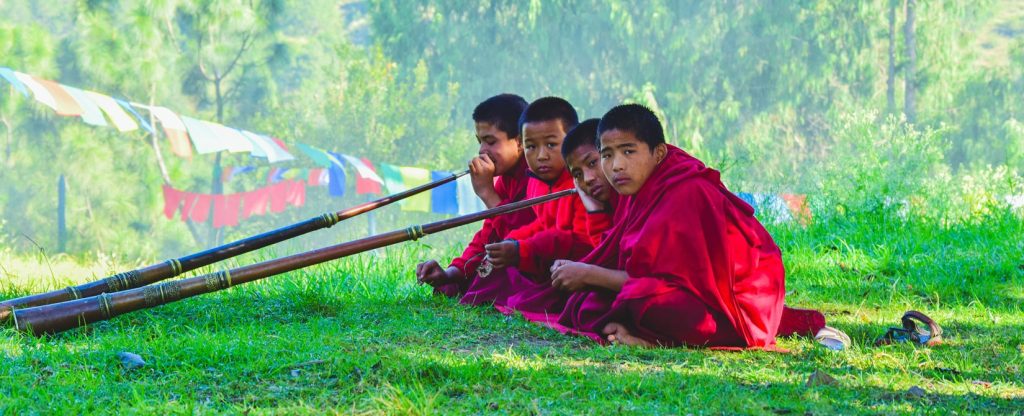
Important facts about Bhutan It is not a surprise that very few people know minimal facts about Bhutan. Even the most experienced travellers will probably be unsure where the location of Bhutan. Bhutan’s government has deliberately remained closed to protect their ancient traditions even though government-approved tours are possible. Despite being a developing nation, the number of tourists entering the country is controlled by high costs. The government has set a high season cost of US$250 per person per day, and this is to discourage mass tourism, which could influence their youths away from their traditions. Bhutan has been off the backpackers’ list because of the high cost. Where Is Bhutan? Bhutan is in the Eastern Himalayas and is a small nation sandwiched between India and Tibet. It is east of Nepal and north of Bangladesh. It is a member country of the South Asian Association for Regional Corporation (SAARC). Facts About Bhutan With 38,359 square kilometres of territory, Bhutan is slightly larger than Taiwan and a little smaller than Switzerland. Most of the country consists of Hilly and mountainous terrain. Druk Yul is the local name for Bhutan. It means “Land of the Thunder Dragon.” The dragon is on the flag of Bhutan. To modernise Bhutan, the past King finally permitted television and internet access into the country only in 1999. Bhutan is among the last nations in the world to allow TV. Some television channels are received from their giant neighbour, India. The past king issued warnings that abuse of television could corrupt their traditional lifestyle. Citizens must wear national dress. The men wear traditional, knee-length garments called “Gho,” and the women wear ankle-length dresses with a silk or brocade blouse called “Kira.” The colours can indicate someone’s status and social class. Bhutan was the first nation to ban the production and sales of tobacco products in 2010. Although it is illegal to smoke in public areas, tobacco products can be used in private. The first King of Bhutan called tobacco the “worst herb” as early as 1916. The violators are slapped with a hefty fine, as much as two months’ average salary. Bhutan is the pioneering nation in creating the measurement of national happiness officially. The index is called Gross National Happiness (GNH). The government has emphasised GNH, prioritising GDP over the rest of the world. This Himalayan nation intends to track the happiness of the population. The United Nations adopted this idea and released a World Happiness report in 2012. Before the focus on internal happiness started, the Bhutanese government was accused of human rights violations against ethnic minorities living there, especially those of Nepalese origin. As a result, 100,000 were forced out of the country or into refugee camps. The United States has accepted more than 95,000 Bhutanese refugees since 2008. The Bhutanese government provides free education. Buddhist teachings are highly prioritised. English is a widely taught second language in its education system. Only 30 per cent of the male and 10% of the female population were literate before the education reform was passed in the 1990s. Bhutan is unique, where the inheritance of land, house, and animals is passed on to the eldest daughter rather than the son or sons, like in most Asian cultures. The husband often moves into his new wife’s home until he becomes financially independent. The Bhutanese were discouraged from marrying foreigners. The law forbids homosexuality. Although polygamy is legal in Bhutan, the practice has become frequent. Archery is the national sport of Bhutan. Soccer is the second most loved sport in Bhutan, while recently, basketball and cricket have been gaining popularity. Vajrayana Buddhism is the national religion of Bhutan. It follows the tantric Buddhist texts. Health, Military, and Politics Bhutan lies directly between two giant neighbours, China and India. These two nations are not on the best terms and clash politically now and again. However, Bhutan is the buffer between these two nations as it controls many crucial high mountain passes. India and Bhutan have a friendly diplomatic relationship. The Bhutanese can cross into India with just their national ID cards, no visa necessary, and work without restrictions. Moreover, many Bhutanese go to India for further studies. Parts of the mountainous borders are still in negotiation with China. Bhutan is still negotiating parts of its mountainous border with China. The Bhutanese have minimal diplomatic relations with their most prominent neighbour, Aside from land disputes. Now and again, the Chinese soldiers begin constructing roads and bridges in sensitive areas that cause uneasiness in Bhutan. The King of Bhutan abdicated and gave the throne to his eldest son in 2008. Thus, King Jigme Khesar Namgyel Wangchuck became the youngest reigning monarch globally at 28. Bhutan became a constitutional monarchy in 2008, with a two-party system. The 2018 People’s Democratic Party won the elections in 2013. The Bhutanese Army consists of around 7500 active soldiers. In addition, the Indian Army trains the Bhutanese force. Bhutan’s economy is growing very swiftly. The Bhutanese currency, the Ngultrum, is pegged to the Indian rupee. The Indian cash is accepted throughout Bhutan. Bhutan attained membership in the United Nations in 1971. It was a founding member of SAARC (South Asian Association of Regional Cooperation) in 1985. Although primary healthcare is free in Bhutan, the country suffers from a severe shortage of doctors. In 2016, the physician density was 0.38 doctors per 1,000 people, according to https://www.cia.gov/library/publications/the-world-factbook/fields/2226.html. In contrast, the United States has around 2.56 doctors per 1,000 residents. Bhutan’s average life expectancy is 69.9 years for males and 71.7 years for females https://www.cia.gov/library/publications/the-world-factbook/fields/2226.html 2017 data. Travelling to Bhutan Bhutan is one of the most restrictive countries in Asia, if not the world. To visit Bhutan as an independent traveller is next to impossible. You will either need t book with a travel company or be invited by a citizen on an official visit. These days the government has lifted the restriction on the number of tourists per year. However, their set price of US$250 per


